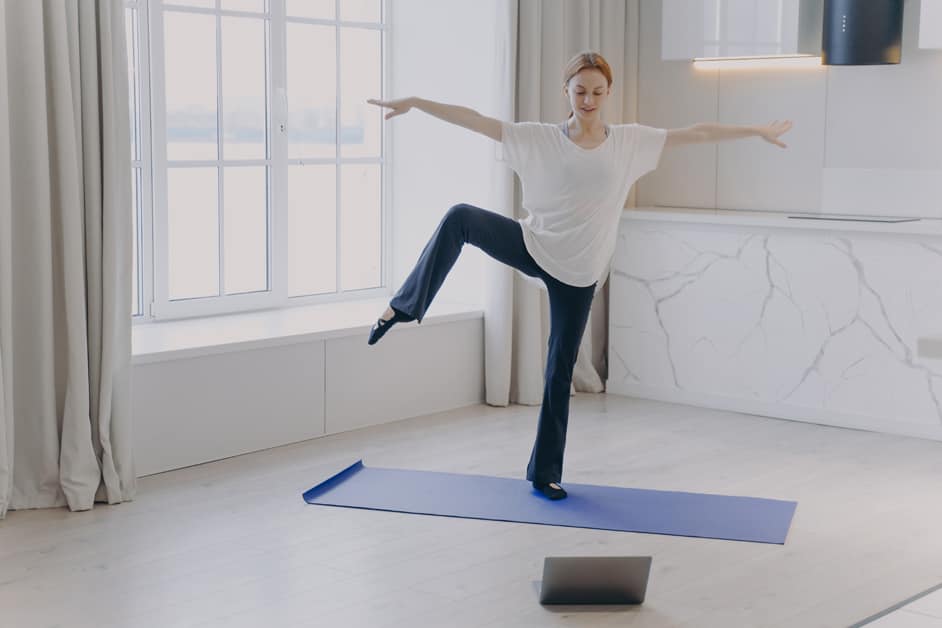Warm-Up
Warming up is must-do before any workout, especially for those with knee pain. Loosen up your muscles and activate joints with dynamic movements and stretches. This will help reduce the chance of injury and also improve flexibility.
Here are some morning warm-up tips if you have knee pain:
- Do low-impact aerobic activities like walking or cycling.
- Perform dynamic stretches like lunges or squats.
- Gradually increase the intensity of your workout.
Light stretching
Light stretching is great for warming up your body before any physical activity, especially when you have knee pain. Stretching loosens tight tissues and reduces pressure on joints, which is good for those with chronic knee pain who plan to exercise in the morning. Dynamic stretching is a form of stretching that moves through specific positions to get your body ready for activity.
Focus on dynamic stretches around your knees to warm up key areas and avoid pain during training. Examples include:
- Leg swings (10 reps each direction)
- Squats (15-20 reps)
- Butt kicks (15-20 reps)
- Straight-leg march (10 each leg)
All this should take no longer than five minutes.
Foam rolling
Foam rolling is an exercise to improve flexibility and reduce pain. It involves rolling a cylinder-shaped foam roller over the body. It helps relieve muscle tension and increase blood flow. It’s a great warm-up for those with knee pain who want to exercise in the morning.
How much time should be spent foam rolling? That depends on the person. Chronic knee pain sufferers should start with 10-15 minutes. Gradually increase over time as strength builds. Increase time a bit each session as the body adapts.
Focus extra time on calf muscles, quads, glutes, IT band stretches, tight hips, or low back muscles. Be aware of proper form. Move slowly and use bodyweight. Take breaks if there are tender points. Concentrate on releasing those spots before returning to exercise.
Dynamic stretching
Dynamic stretching is an effective warm-up technique. It helps improve range of motion and prepares muscles for exercise. It relaxes tight muscles and connective tissues, and helps increase joint stability.
Move slowly and with control. Stand upright with feet shoulder width apart. Lift one knee up towards chest while keeping other leg extended. Keep hips level. Repeat on other leg. Alternate between legs for 10 reps (total 20). Lightly skip 3-5 times, keeping posture good. Avoid excessive side-to-side or forward-backward movements. Jump in place for 10 reps, landing on both feet each time.
Dynamic stretching should be done for 4-5 mins before activity. This helps warm up muscles and joints to avoid potential discomfort during exercise.
Balance Training
Balance training is essential to decrease knee ache and avert additional hurt. To improve the strength, suppleness, and control of your knee muscles, consider balance training. In this article, we’ll share some tips to help you add balance training to your morning exercise schedule.
Single-leg balance exercises
Single-leg balance exercises are a great way to tackle knee pain! They can be done anywhere and fit into any workout routine. Plus, they help to prevent injury and lessen pain in the future.
Start slowly, as these exercises are training your core muscles for better balance. Use handrails or a wall/chair for support. Make sure you have good form throughout.
Here are a few single-leg balance drills:
- Step downs: Stand on a flat surface, feet 12-18 inches apart. Bring one foot back 6-12 inches. Squat down, tucking tailbone, keeping chest up and eyes forward. Tap the heel of the trailing foot. Stand back up without leaning forward. Do 3 sets of 8 reps, twice weekly.
- Wall touches: Stand against a wall, feet shoulder distance apart. Touch one hand down, grab near ankle/shin. Raise other arm above head. Pause briefly. Do 8 reps, 3 times weekly.
- Side Plank rotations: Balance on one leg, feet wider than shoulder distance apart. Face away from wall, trunk supported by handrails. Reach opposite arm across body towards wall. Rotate torso. Return opposite arm back. Repeat 8×3 times, twice weekly.
Single-leg balance with weights
Single-leg balance with weights is a great way to make your knee stronger and better your balance. Warm up properly before attempting any balance exercises with weights.
Goal: stand on one leg while holding a weighted object in each hand and do your regular single-leg balance with more intensity.
- Start with your right foot and lift your left leg as high as you can. Hold for a few seconds, then lower your left foot. Do a few reps, then lift and lower a small or moderate weight from side to side above your head slowly.
- As you do this, be aware of your body’s movements and stay in control throughout the exercise.
- Keep good posture and breathe deep belly breaths for abdominal support. Arms should remain straight, but not locked out. They should stay soft and flexible to changes in body position or weight shifts.
- Repeat as needed on both sides and make this part of your morning workout routine if you have knee pain. Strengthening the knee joint mobility and stability while improving your overall physical health!
Balance board exercises
Balance board exercises are ideal for enhancing balance, proprioception, and strength. Position one foot on a board or stability pad on the floor and the other off the ground. The aim is to stay balanced while doing various motions such as squats, single-leg Romanian deadlifts, single-leg lateral lunges, and hand balancing. Anyone can add these to their regular workout routine. They are especially good for those with knee pain because they improve balance in the affected area.
When you start balance training, go slow. Master simple movements on each side first. Always keep your knees slightly bent while doing the exercise. Try different directions and vary the speed. To make the exercises more effective, increase the time duration or move from an open chain to closed chain motion. This is especially beneficial for those who exercise in the morning and suffer from knee pain.
Cool-Down
Cooling down is essential after a workout. It helps lessen knee pain, and can make you less stiff! Cool-down activities help reduce inflammation, lactic acid, and muscle stiffness.
This section will explain why cooling down is necessary for those with morning knee pain, and how you can do balance training to cool-down properly.
Static stretching
Static stretching plays an important role in any workout session for athletes. This type of stretching involves staying still in a comfortable position and stretching your muscles without bouncing. It is best to do static stretches after each exercise to relax the muscles and reduce pain. This gradually elongates the muscles. It should be combined with dynamic stretches for best results before and after training.
Static stretches should be held for 10-30 seconds. You can incorporate whatever methods you like, such as reaching, bending or lying down. Lower body exercises like squats, lunges, calf exercises and single leg balances are particularly beneficial for managing knee pain as they have low-impact.
Hydrating your body is essential for successful static stretching. Drink water throughout the day and avoid dehydration; this will ease discomfort during exercise. Also, listen to your body’s needs. If you experience any discomfort, stop and consult a doctor or physical therapist for treatment.
Foam rolling
Foam rolling is a must for cool-downs. It’s great for knee pain relief! It increases flexibility, reduces tension, and boosts range of motion. All of these are important for avoiding injury.
You need a foam roller and timer. Lie flat on your back with the roller under your knees. Let it move around while you keep your legs straight. Relax and stay like this for 20 seconds. Roll up each side of your leg for 10 seconds each, then switch sides.
Switch positions. Put one arm down and one leg on the floor. Take the other leg and hold it up parallel to the ground with both hands. Push into each area above or below the knee joint in circles for 30-60 seconds. Repeat a few times. Switch legs.
Take a few minutes to relax your muscles. Then do any extra cool-down steps or sports activities that target lower body imbalances.
Breathing exercises
Breathing correctly can relax muscles and help warm up and cool down during exercise. It can also increase oxygen to the spine and lower body, reducing pain from knee injuries.
Start by finding a comfortable standing or seated position. Inhale deeply through the nose for 5 seconds, expanding the stomach. Exhale slowly out of the mouth for 5 seconds. Repeat this exercise two more times. Move onto other warm-up and cool-down exercises, such as gentle yoga poses. This will loosen tight muscles in the areas around the injured knee joint.
With proper breath control during balance activities, you can strengthen sensory muscles and reduce joint stiffness. Balance exercises that incorporate breathing can be done at home, improving proprioception and reducing further injury.
Additional Tips
Knee injuries can be super painful. For those who exercise morningly, staying balanced can be hard. But, with the correct balance training, it’s possible to dodge knee pain and still gain strength.
Here are some extra tips:
Wear supportive shoes
For roasting coffee beans, supportive shoes are a must. Choose shoes with low heels and good arch support. This will reduce strain on your body. The shoes should also be breathable to keep your feet cool and dry. Non-slip soles are a must in case of wet or greasy surfaces. Steel-toed boots are recommended if you plan on working with hot machinery or roasting pans. Wearing supportive shoes can make your roasting experience safer and comfier.
Avoid high-impact exercises
Mornin’ exercise sesh’s can be a big help for those strugglin’ with knee pain. But, it’s important to get advice from yer doc and physio before you start. High-impact exercises like running, jump rope, and kickboxin’ can do more damage to weak joints. So, go for low-impact aerobic activities like walking, swimming, and biking. Plus, lift some weights.
In certain cases, yoga and Pilates can be a good choice too, as they help strengthen joints without too much strain. Remember to start slow and build up yer strength and endurance with these lower impact exercises before attemptin’ something more strenuous.
Listen to your body
Knee pain sufferers must adjust their workouts. Pay attention to how your body feels. Increase intensity if possible, but take a break if symptoms worsen. Listening to your body is key to avoiding injury and soreness.
Warm up for 10 minutes before any workout. Do light cardio and stretch to increase flexibility. Mobility exercises help synchronize lower extremity movement patterns too. This reduces tension and pain during/after activities.
Frequently Asked Questions
Q1: What type of balance training is best for knee pain sufferers?
A1: Weight-bearing exercises that focus on proprioception and balance, such as single-leg deadlifts, single-leg squats, and one-legged balance drills, are beneficial for knee pain sufferers.
Q2: What should knee pain sufferers do before working out in the morning?
A2: Knee pain sufferers should do a few minutes of light stretching, foam rolling, and strengthening exercises before beginning any workout. This will help prevent further injury and reduce knee pain.
Q3: Is it better to do balance training exercises in the morning or evening?
A3: It is best to do balance exercises in the morning, as this helps to warm up the body and prepare it for a more strenuous workout. This is especially true for those who suffer from knee pain.





